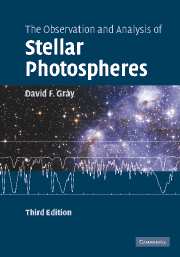Book contents
- Frontmatter
- Contents
- Preface to the first edition
- Preface to the second edition
- Preface to the third edition
- 1 Background
- 2 Fourier transforms
- 3 Spectroscopic tools
- 4 Light detectors
- 5 Radiation terms and definitions
- 6 The black body and its radiation
- 7 Radiative and convective energy transport
- 8 The continuous absorption coefficient
- 9 The model photosphere
- 10 The measurement of stellar continua
- 11 The line absorption coefficient
- 12 The measurement of spectral lines
- 13 The behavior of spectral lines
- 14 The measurement of stellar radii and temperatures
- 15 The measurement of photospheric pressure
- 16 Chemical analysis
- 17 Velocity fields in stellar photospheres
- 18 Stellar rotation
- Appendix A A table of useful constants
- Appendix B Physical parameters of stars
- Appendix C A fast Fourier transform Fortran program
- Appendix D Atomic data
- Appendix E The strongest lines in the solar spectrum
- Appendix F Computation of random errors
- Index
- References
7 - Radiative and convective energy transport
Published online by Cambridge University Press: 05 March 2015
- Frontmatter
- Contents
- Preface to the first edition
- Preface to the second edition
- Preface to the third edition
- 1 Background
- 2 Fourier transforms
- 3 Spectroscopic tools
- 4 Light detectors
- 5 Radiation terms and definitions
- 6 The black body and its radiation
- 7 Radiative and convective energy transport
- 8 The continuous absorption coefficient
- 9 The model photosphere
- 10 The measurement of stellar continua
- 11 The line absorption coefficient
- 12 The measurement of spectral lines
- 13 The behavior of spectral lines
- 14 The measurement of stellar radii and temperatures
- 15 The measurement of photospheric pressure
- 16 Chemical analysis
- 17 Velocity fields in stellar photospheres
- 18 Stellar rotation
- Appendix A A table of useful constants
- Appendix B Physical parameters of stars
- Appendix C A fast Fourier transform Fortran program
- Appendix D Atomic data
- Appendix E The strongest lines in the solar spectrum
- Appendix F Computation of random errors
- Index
- References
Summary
The dominant mechanism of energy transport through the surface layers of a typical star is radiation, i.e., photons. Transport by convection is often important below the surface, but rarely carries a significant fraction of the flux in the photosphere. Conduction comes into play in extreme cases such as white dwarfs. So it is radiative transfer that is our main focus here. It is in the domain of radiative transfer where the physical parameters of the material comprising the star are coupled to the spectrum we see and measure. We start by setting up the differential equation describing the flow of radiation through an infinitesimal volume. The integration of the equation can then be accomplished for the geometry of the situation. Unfortunately the step from a differential to an integral equation is not a physical solution to the problem because the integrand still depends on the atomic excitation of the material, which itself depends on the temperature of the material, and the radiation field in the material. Both the thermal (collisional) and the non-thermal (radiative) excitation vary with depth in the photosphere. In most applications of the theory to real stars, a numerical model of the star's photosphere is formed from which the integrand and then the spectrum of the star can be calculated. This chapter, along with Chapters 8 and 9, develops the tools for this modeling.
- Type
- Chapter
- Information
- The Observation and Analysis of Stellar Photospheres , pp. 127 - 146Publisher: Cambridge University PressPrint publication year: 2005



